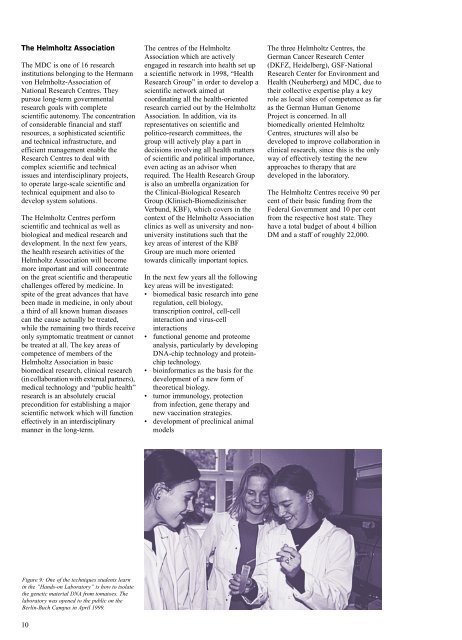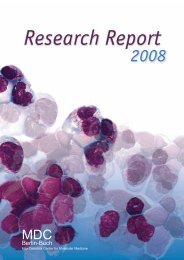You also want an ePaper? Increase the reach of your titles
YUMPU automatically turns print PDFs into web optimized ePapers that Google loves.
The Helmholtz Association<br />
The <strong>MDC</strong> is one of 16 research<br />
institutions belonging to the Hermann<br />
von Helmholtz-Association of<br />
National <strong>Research</strong> Centres. They<br />
pursue long-term governmental<br />
research goals with complete<br />
scientific autonomy. The concentration<br />
of considerable financial and staff<br />
resources, a sophisticated scientific<br />
and technical infrastructure, and<br />
efficient management enable the<br />
<strong>Research</strong> Centres to deal with<br />
complex scientific and technical<br />
issues and interdisciplinary projects,<br />
to operate large-scale scientific and<br />
technical equipment and also to<br />
develop system solutions.<br />
The Helmholtz Centres perform<br />
scientific and technical as well as<br />
biological and medical research and<br />
development. In the next few years,<br />
the health research activities of the<br />
Helmholtz Association will become<br />
more important and will concentrate<br />
on the great scientific and therapeutic<br />
challenges offered by medicine. In<br />
spite of the great advances that have<br />
been made in medicine, in only about<br />
a third of all known human diseases<br />
can the cause actually be treated,<br />
while the remaining two thirds receive<br />
only symptomatic treatment or cannot<br />
be treated at all. The key areas of<br />
competence of members of the<br />
Helmholtz Association in basic<br />
biomedical research, clinical research<br />
(in collaboration with external partners),<br />
medical technology and “public health”<br />
research is an absolutely crucial<br />
precondition for establishing a major<br />
scientific network which will function<br />
effectively in an interdisciplinary<br />
manner in the long-term.<br />
Figure 9: One of the techniques students learn<br />
in the ”Hands-on Laboratory” is how to isolate<br />
the genetic material DNA from tomatoes. The<br />
laboratory was opened to the public on the<br />
Berlin-Buch Campus in April 1999.<br />
10<br />
The centres of the Helmholtz<br />
Association which are actively<br />
engaged in research into health set up<br />
a scientific network in 1998, “Health<br />
<strong>Research</strong> Group” in order to develop a<br />
scientific network aimed at<br />
coordinating all the health-oriented<br />
research carried out by the Helmholtz<br />
Association. In addition, via its<br />
representatives on scientific and<br />
politico-research committees, the<br />
group will actively play a part in<br />
decisions involving all health matters<br />
of scientific and political importance,<br />
even acting as an advisor when<br />
required. The Health <strong>Research</strong> Group<br />
is also an umbrella organization for<br />
the Clinical-Biological <strong>Research</strong><br />
Group (Klinisch-Biomedizinischer<br />
Verbund, KBF), which covers in the<br />
context of the Helmholtz Association<br />
clinics as well as university and nonuniversity<br />
institutions such that the<br />
key areas of interest of the KBF<br />
Group are much more oriented<br />
towards clinically important topics.<br />
In the next few years all the following<br />
key areas will be investigated:<br />
• biomedical basic research into gene<br />
regulation, cell biology,<br />
transcription control, cell-cell<br />
interaction and virus-cell<br />
interactions<br />
• functional genome and proteome<br />
analysis, particularly by developing<br />
DNA-chip technology and proteinchip<br />
technology.<br />
• bioinformatics as the basis for the<br />
development of a new form of<br />
theoretical biology.<br />
• tumor immunology, protection<br />
from infection, gene therapy and<br />
new vaccination strategies.<br />
• development of preclinical animal<br />
models<br />
The three Helmholtz Centres, the<br />
German Cancer <strong>Research</strong> Center<br />
(DKFZ, Heidelberg), GSF-National<br />
<strong>Research</strong> Center for Environment and<br />
Health (Neuherberg) and <strong>MDC</strong>, due to<br />
their collective expertise play a key<br />
role as local sites of competence as far<br />
as the German Human Genome<br />
Project is concerned. In all<br />
biomedically oriented Helmholtz<br />
Centres, structures will also be<br />
developed to improve collaboration in<br />
clinical research, since this is the only<br />
way of effectively testing the new<br />
approaches to therapy that are<br />
developed in the laboratory.<br />
The Helmholtz Centres receive 90 per<br />
cent of their basic funding from the<br />
Federal Government and 10 per cent<br />
from the respective host state. They<br />
have a total budget of about 4 billion<br />
DM and a staff of roughly 22,000.

















